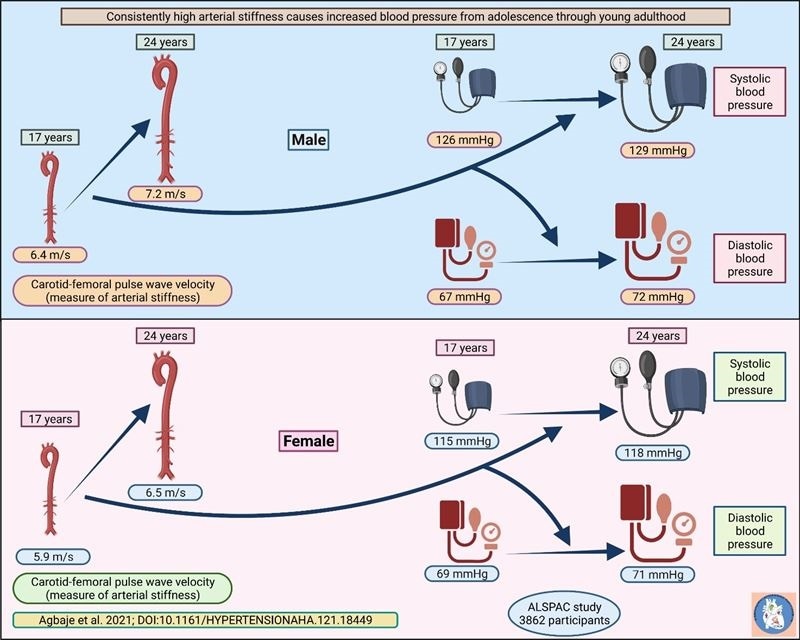Reviewed by Danielle Ellis, B.Sc.Nov 19 2021
Researchers from the University of Eastern Finland, the University of Exeter, and the University of Bristol carried out the study using data from one of the world’s most extensive ongoing prospective birth cohort studies – the Avon Longitudinal Study of Parents and Children (ALSPAC).

Atherosclerotic traits referred to as arterial stiffness seem to independently cause elevated blood pressure and hypertension among adolescents and young adults. The prevention and treatment of hypertension among the young population should include strategies to decrease arterial stiffness. Image Credit: Andrew Agbaje.
Globally, hypertension and obesity are major preventable risk factors for atherosclerotic cardiovascular diseases and death. However, several efforts to decrease the incidence and prevalence of hypertension and obesity have yielded minimal effects. Hence, understanding the natural development and pathogenesis of hypertension and obesity is important to decreasing these risks. In the newly published study, the researchers examined whether atherosclerotic traits such as arterial stiffness temporally precede the development of hypertension and obesity. This is the first time over 3800 adolescents, aged 17 years were followed up for seven years. The researchers employed several statistical approaches to untangle potential causal associations.
The researchers found that higher arterial stiffness during adolescence increased the risk of systolic hypertension by 20 percent and diastolic hypertension by two-fold, seven years later. Moreover, participants were categorized into four equal groups according to their level of arterial stiffness. Adolescents whose arterial stiffness levels were in the highest quartile both at 17 years of age and 24 years of age had a systolic blood pressure increase of 4 mmHg, and their diastolic blood pressure increased by 3 mmHg during the seven-year observation period. Of note, mild elevations in systolic and diastolic blood pressure were also observed in adolescents with mildly increased arterial stiffness but within normal limits. However, the change in blood pressure in the “mild” group was half that of the change in the “high” group. These results were similar in both males and females, despite controlling for important risk factors such as smoking, physical activity, lipid and glucose, body fat, heart rate, family history of cardiovascular diseases, etc.
Previous studies have focused on the adverse effect of obesity on the heart and blood vessels. However, the present study found that higher arterial stiffness at age 17 years increased the risk of abdominal obesity and whole body obesity by 20 percent at age 24 years. The findings reveal a possible two-way direction between unhealthy arteries and obesity, although the evidence was stronger for obesity leading to unhealthy arteries, and not vice versa.
A recent American Heart Association scientific statement notes that “lifestyle modification, including diet, reduced sedentariness, and increased physical activity, is usually recommended for patients with obesity; however, the long-term success of these strategies for reducing adiposity, maintaining weight loss, and reducing blood pressure has been limited”. It has also been established that a 5 mmHg rise in blood pressure over five years increases the risk of death in the adult population by 16 percent.
Therefore, our novel findings are significant clinically and for population health, in that future hypertension and obesity prevention and treatment strategies may now consider reducing arterial stiffness, particularly from adolescence,”
Andrew Agbaje, Physician and Clinical Epidemiologist, University of Eastern Finland
This research was supported in part by research grants from Jenny and Antti Wihuri Foundation, the Finnish Cultural Foundation Central Fund, the Finnish Cultural Foundation North Savo Regional Fund, and the Doctoral Programme of Clinical Research, Faculty of Health Sciences, University of Eastern Finland. The UK Medical Research Council, Wellcome Trust, and the University of Bristol provided core support for the ALSPAC study. The figure was created with Biorender.com
Source:
Journal reference:
Agbaje, A.O., et al. (2021) Effects of arterial stiffness and carotid intima-media thickness progression on the risk of overweight/obesity and elevated blood pressure/hypertension: a cross-lagged cohort study. Hypertension. doi.org/10.1161/HYPERTENSIONAHA.121.18449.